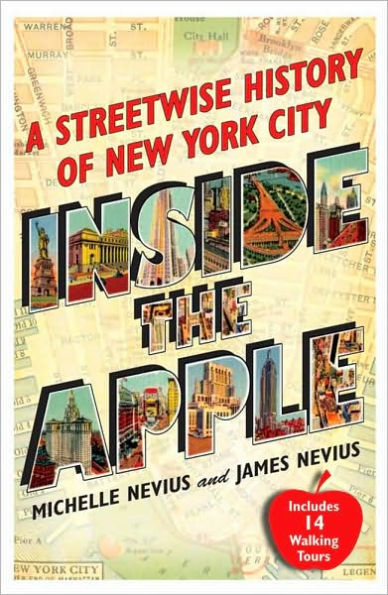Dear Literary Lady, I’ve grown weary of New York City over the years, but I’m trapped here because of work, family, and other obligations. What can I read to help me get over my disenchantment with where I live? I want to love the City again and stop being miserable here. –T.C., New York, NY […]
Inside the Apple: A Streetwise History of New York City
How much do you actually know about New York City? Did you know they tried to anchor Zeppelins at the top of the Empire State Building? Or that the high-rent district of Park Avenue was once so dangerous it was called “Death Avenue”? Lively and comprehensive, Inside the Apple brings to life New York's fascinating past.
This narrative history of New York City is the first to offer practical walking tour know-how. Fast-paced but thorough, its bite-size chapters each focus on an event, person, or place of historical significance. Rich in anecdotes and illustrations, it whisks readers from colonial New Amsterdam through Manhattan's past, right up to post-9/11 New York. The book also works as a historical walking-tour guide, with 14 self-guided tours, maps, and step-by-step directions. Easy to carry with you as you explore the city, Inside the Apple allows you to visit the site of every story it tells. This energetic, wide-ranging, and often humorous book covers New York's most important historical moments, but is always anchored in the city of today.
1100331245
This narrative history of New York City is the first to offer practical walking tour know-how. Fast-paced but thorough, its bite-size chapters each focus on an event, person, or place of historical significance. Rich in anecdotes and illustrations, it whisks readers from colonial New Amsterdam through Manhattan's past, right up to post-9/11 New York. The book also works as a historical walking-tour guide, with 14 self-guided tours, maps, and step-by-step directions. Easy to carry with you as you explore the city, Inside the Apple allows you to visit the site of every story it tells. This energetic, wide-ranging, and often humorous book covers New York's most important historical moments, but is always anchored in the city of today.
Inside the Apple: A Streetwise History of New York City
How much do you actually know about New York City? Did you know they tried to anchor Zeppelins at the top of the Empire State Building? Or that the high-rent district of Park Avenue was once so dangerous it was called “Death Avenue”? Lively and comprehensive, Inside the Apple brings to life New York's fascinating past.
This narrative history of New York City is the first to offer practical walking tour know-how. Fast-paced but thorough, its bite-size chapters each focus on an event, person, or place of historical significance. Rich in anecdotes and illustrations, it whisks readers from colonial New Amsterdam through Manhattan's past, right up to post-9/11 New York. The book also works as a historical walking-tour guide, with 14 self-guided tours, maps, and step-by-step directions. Easy to carry with you as you explore the city, Inside the Apple allows you to visit the site of every story it tells. This energetic, wide-ranging, and often humorous book covers New York's most important historical moments, but is always anchored in the city of today.
This narrative history of New York City is the first to offer practical walking tour know-how. Fast-paced but thorough, its bite-size chapters each focus on an event, person, or place of historical significance. Rich in anecdotes and illustrations, it whisks readers from colonial New Amsterdam through Manhattan's past, right up to post-9/11 New York. The book also works as a historical walking-tour guide, with 14 self-guided tours, maps, and step-by-step directions. Easy to carry with you as you explore the city, Inside the Apple allows you to visit the site of every story it tells. This energetic, wide-ranging, and often humorous book covers New York's most important historical moments, but is always anchored in the city of today.
20.0
In Stock
5
1

Inside the Apple: A Streetwise History of New York City
384
Inside the Apple: A Streetwise History of New York City
384Paperback(Original)
$20.00
20.0
In Stock

Product Details
| ISBN-13: | 9781416589976 |
|---|---|
| Publisher: | Free Press |
| Publication date: | 03/24/2009 |
| Edition description: | Original |
| Pages: | 384 |
| Sales rank: | 610,065 |
| Product dimensions: | 5.50(w) x 8.30(h) x 1.10(d) |
About the Author
From the B&N Reads Blog
